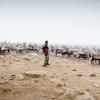One man’s breath is another man’s death. That may sound extreme, but there’s an element of truth in it. In Fennoscandia (the northern areas of Norway, Sweden and Finland) this could become a reality.
From a political point of view, there’s interest in investing in green solutions in large unutilised northern areas. This can be in the form of mineral extraction, wind farms and railway facilities. This was also discussed when Norway’s Minister of Climate and Environment Espen Barth Eide (Labour Party) visited Tromsø in early May to talk about the large untapped natural resources in northern Norway.
However, an expansion of green solutions can have consequences for reindeer husbandry in the area, which requires large, connected areas of land. This is emphasised by Øystein Holand, Professor at the Norwegian University of Life Sciences (NMBU).
He leads the recently completed NordForsk-funded project Reindeer husbandry in a Globalizing North - resilience, adaptations and pathways for actions (ReiGN). The purpose of ReiGN has been to investigate in what ways climate change is affecting reindeer husbandry in Fennoscandia, and how the industry can adapt to the conditions.
“I think the biggest threat to reindeer husbandry as we know it today, is the conflict over the area. Everyone agrees that the green transition is necessary. Climate change is also hitting reindeer husbandry hard, but many of the solutions to climate change can lead to more difficult conditions for reindeer husbandry in particular,” says Holand.

Climate goals and local interests
Reindeer husbandry is a marginal industry, and it’s often linked to Sami culture and traditions. The conflict between indigenous peoples’ reindeer husbandry and the desire of large state and private companies to establish sustainable initiatives is a tricky one.
How do we balance the interest between fulfilling climate goals, and at the same time take into account the traditions and culture of the indigenous peoples – in this case reindeer husbandry? This is one of the questions that Øystein Holand and the rest of the research team have investigated.
“As researchers, we try to uncover what the conflict is about, but in the end it’s a political issue. Different objectives conflict with each other and there are many interests to consider. The indigenous peoples are afraid of losing more land, and their rights are safeguarded through national and international conventions, just as the Norwegian Constitution states that Sami rights and culture must be taken into account. On the other hand, we have international and national climate goals, which require a green transition, and Fennoscandia plays a major role in that because these are large areas of land. It’s difficult to accommodate all parties.”
For example, Holand mentions several disputes over the development of sustainable solutions in northern Norway. One of them was about the development of a large wind farm in Nordtrøndelag, which was declared invalid by the Norwegian Supreme Court because the development violated Sami rights.

Impact of the research
The researchers involved in the project have been active in disseminating their results and advising on reindeer husbandry cases. One of the Swedish researchers in the project has been an advisor in various EU panels and the Sami Parliament in Sweden, while a Finnish researcher has advised on issues regarding reindeer husbandry in Finland, and another researcher in Norway has been part of an expert committee to limit the transmission of CWD (Chronic Wasting Disease) among wild reindeer herds.
“Our research results in connection with the ReiGN project have been very useful, and we have played an active role in the collaboration with administrators, the Sami communities, politicians and the judiciary in cases concerning reindeer husbandry.”
Co-operation across the Nordic Region creates Nordic added value
The project involves researchers from Norway, Sweden and Finland, who all come from different disciplines. ReiGN’s desire has been to bring researchers together from different disciplines to take an interdisciplinary approach as much as possible. In addition, they have collaborated with two other Nordic centres of excellence funded by NordForsk, namely CLINF and REXSAC.
“It’s been quite rewarding to collaborate across the Nordic countries and with the other research centres in NordForsk’s Arctic programme. It’s our younger researchers in particular who have initiated the collaboration, and together with CLINF and REXSAC, we’ve held workshops, among other things.”
As a result of the project, the researchers have published the book Reindeer Husbandry and Global Environmental Change – Pastoralism in Fennoscandia (open access).




